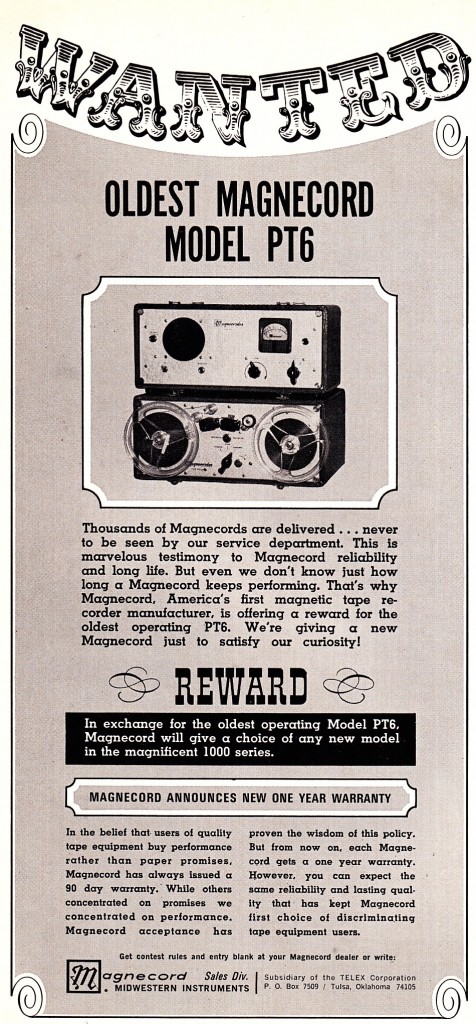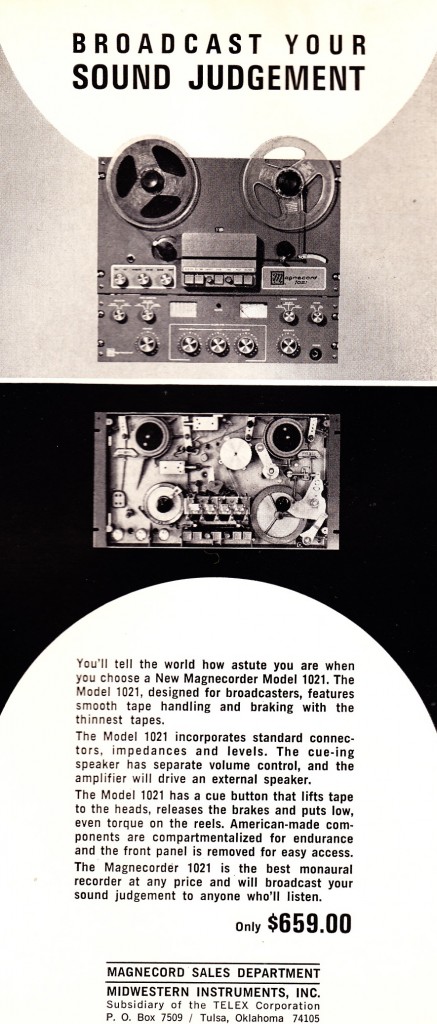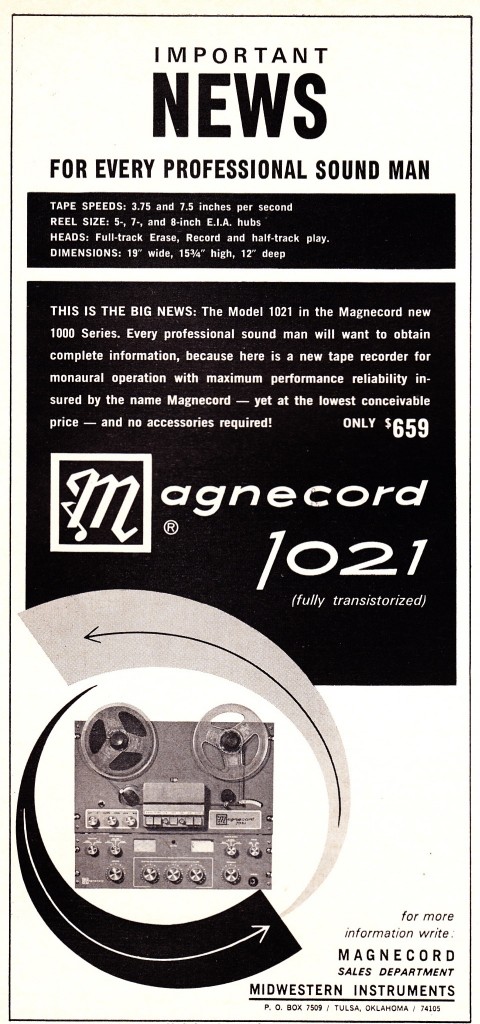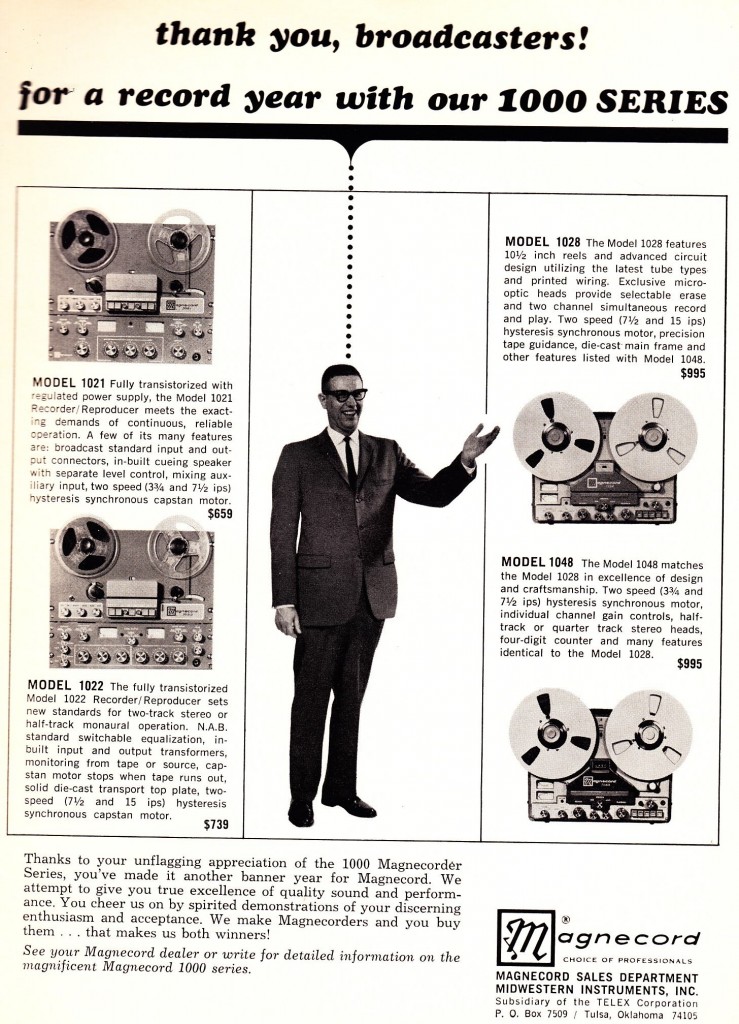 There is a lot of Magnecord material on PS dot com… I didn’t plan it, it just kinda happened. Which is the story of my life in general. For better and for worse. I was at the flea mkt a coupla years ago and I found a pair of Magnecord PT6s, complete and in nice road cases, for $25 each. I fixed ’em up, made some recordings with them, and then stuck em in the studio (where they have actually been used on sessions, BION). The circa 1963 advert you see above is no joke. My PT6s are close to 65 years old and they still work fine. How many other pieces of pro audio hardware can you say that about?
There is a lot of Magnecord material on PS dot com… I didn’t plan it, it just kinda happened. Which is the story of my life in general. For better and for worse. I was at the flea mkt a coupla years ago and I found a pair of Magnecord PT6s, complete and in nice road cases, for $25 each. I fixed ’em up, made some recordings with them, and then stuck em in the studio (where they have actually been used on sessions, BION). The circa 1963 advert you see above is no joke. My PT6s are close to 65 years old and they still work fine. How many other pieces of pro audio hardware can you say that about?
Soon I heard from the son of the guy who designed a lot of the circuitry (and the heads) of the PT6. Back in the 1940s. The Boyers family sent me just a ton of material that had never been made widely available (you can start here), and I uploaded it all… the end result of all this being that if you search the WWW for ‘Magnecord,’ yr gonna end up here. BUT. But but but. So far I’ve only touched on Magnecord in 195os. Today I will introduce some materials relating to the Magnecord of the 1960s. I’ve never personally seen, or used, any of these decks. But maybe you have. Contributions welcome in the comments section…
 Above: The Magnecord 1021 Mono recorder circa 1964. Anyone? What was the equivalent level of machine in the Ampex line?
Above: The Magnecord 1021 Mono recorder circa 1964. Anyone? What was the equivalent level of machine in the Ampex line?
 Above: another advert for the 1021.
Above: another advert for the 1021.
 Above: by 1965, the Magnecord 1000 series included the 1021, its stereo cousin the 1022, the stereo 1028 (a higher-end model that used tubes? strange…) and the 1048, which seems to be similar to the 1028 in all respects other than tape handling speed.
Above: by 1965, the Magnecord 1000 series included the 1021, its stereo cousin the 1022, the stereo 1028 (a higher-end model that used tubes? strange…) and the 1048, which seems to be similar to the 1028 in all respects other than tape handling speed.
15 replies on “Magnecord Tape Machines of the Early 1960s”
Great article.
I have a Magnacord 1028 that I used to record tracks for several LP records back in the 1970s. Still have it, but the heads are shot.
-PF
I just so happen to have a 10 28 like new very great condition working order um make me an offer
Hello, I have a couple of Magnecord model 728 recorders. One unit has the input/output transformers which are removeable having 8 pin octal type bases . I have been trying to locate these transformers for the other machine, but so far have had no luck in doing so, and would surely appreciate any help anyone could provide in locating them. Thank you very much ——- Greg Richardson
Does anyone know the turns ratio for these? Greg, you could always use a basic signal generator app or device and a volt meter to determine the turns ratio of the units that you do possess, and then buy the similar vintage UTC A-series units on ebay; these will easily mount on a generic octal plug w/a metal retaining plate. Theres a post on this website somewhere describing this mounting technique.
thanks for your information Chris. I think I will remove and inspect the input/output transformers in the one machine, and then try to match the info on them with the specs on the similar transformers in the UTC catalog. The recorder is a 1960 vintage and the catalog is 1962 – 63 so there may be a suitable substitute. Your idea of determining the turns ratio with a sig generator and voltmeter is a good one , and I may give it a try. I have a feeling that a direct substitute may be available if it could just be located.
Greg . . . Did you ever find transformers for your 728 that matched the ones you already have? If so, could you kindly relay what you used and where to get them?
I’ve been researching input transformers for my 728 as well. Given that I only plan on using it as a mastering deck (in other words, no mic-level signals), the best advice I’ve gotten thus far is to bypass a gain stage and connect a Jensen line-matching transformer to the gain pot.:
https://www.gearslutz.com/board/geekslutz-forum/1128320-line-input-transformer-does-care-whether-feeds-pentode-triode.html
That sounds like a wise idea to me. AFAIK, the best move here is to use a transformer such that the reflected impedance of the secondary is 1/10th that of the pot value (IE., if it’s a 100k pot and your source into the deck is 600 ohm, use a 600:10k transformer or even one with a lower turns ratio. This SHOULD minimize any timbral shift accompanying pot position. Other folks may have other advice…
[…] more, a couple of years ago I picked up a truly ancient Magnecord 728. With any luck, someday soon–okay, not that soon–you’ll see me hauling this […]
At this time without doing further research, I seem to recall that the 1028 was a ‘half track’ unit that recorded in stereo using one half the tape per channel in one direction only, whereas the 1048 model recorded ‘quarter track’ stereo on one forth the tape per channel but the reels could be ‘flipped over’ to reverse the direction; I think this would be compatible with ‘standard’ stereo decks. Of course, due to the nature of the construction of the record/playback head assembly, a machine could easily be converted to utilize any head arrangement so one might find a model with either heads.
P.S. I have a 1028 that has been stored away since the early 1980’s after I purchased an Akai 635D for convenience which was able to play the Magnecord tapes in one direction only. The Magnecord has/had a warmer sound and I even used it in the mid 1970’s to tape a master for a live album released by an area band.
I have dozens of early Magnecord transports and preamps (some believed to be Demo’s & prototypes) and hundreds/thousands of parts and manuals. All from the estate of Feador Van Den Dool a WW2 hero and 70 year employee of Magnecord/Midwest/Telex. I’d like to sell this collection to a passionate enthusiast, please give me a call Chris (918) 949-5626
Did you sell these parts?
I have a Magnecord 1024 which I bought new in the 1960’s. It is still like new and working …It has been well maintained. Replaced the idler and belt …serviced the electronics once…. made to last I would say
hello, all. I acquired a 728 (strangely, the model number is stamped as 728-44) some years ago. It has sat static for those years and I assume for some years prior to my acquisition. My first of probably many questions – can someone point me to a resource as this does not seem so much like a bulletin board for such use. In the case that no one has such, first problem is. the power cord is stiff and dry (rubber casing) and gives me pause to even start the troubleshooting.
Any luck in sourcing output transformers? I have a 1048 that needs the upgrade. Thanks